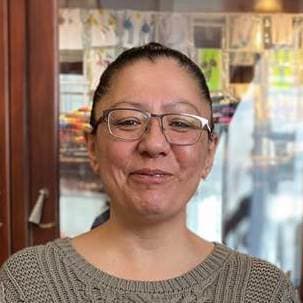Even though Janice Johnstone, member of the Muskeg Lake Cree Nation, has been beading for over twenty years, she’s never done a dream catcher like this one before. “I make little ones for your car with pendant feathers. And I’ve done a big one before with fringes. But never one this big with a centrepiece. I used the biggest hoop ring I could find – it’s half webbing and half centrepiece. But the fringes were the hardest part.”
If you look closely, you can see the tiny feathers that Janice beaded around the ring of the dreamcatcher. “I chose the feathers because they are sacred in our culture. I thought about using tipis, but feathers made more sense.”
Janice learned to bead from her grandma, her dad’s mom, who used to make moccasins. Janice, in kindergarten at the time, was allowed to watch – but never allowed to touch the beads. Her youngest granddaughter is about the same age now, which has given Janice a bit of perspective. “She just likes to mess up the beads!” she laughs. But beading is a real family affair for Janice. “My older granddaughter helps me manage my bead collection. And both my daughter, whom I taught to bead, and my mother help me with projects.”
Beadwork is a source of relaxation for Janice, though because it is so time-consuming – beading the Petro-Canada dream catcher took her eight hours a day, beading every day for about 6 weeks – she has to be careful not to take on too many projects. In addition to the smaller dream catchers, Janice has created pin designs like poppies and orange shirts, as well as several medallions for people to wear, often with bear paws or hockey logos. “I created a medallion for the Chief of Muskeg Lake Cree Nation. He was in the Canadian army and it represented his platoon (Princess Patricia’s Canadian Light Infantry 3rd Battalion).”
Both Janice’s mom and her mom’s parents went to Residential school. But she didn’t know about children who were missing or dying. Her mom, her family never talked about it. “I grew up in Saskatoon. I was allowed to visit the reserve but never had to go to the schools. All my friends have someone in their family who went. That’s why Truth and Reconciliation is so important. It honours all the children who were stolen. They were our future, and they were taken away.”
For Janice, initiatives like Petro-Canada’s beaded logo project are an important contribution to Truth and Reconciliation. “Asking for participation from Indigenous artists and sharing Indigenous cultures helps. Putting a logo like this up, whether at sites across Canada or online, helps. It recognizes what Indigenous people have gone through. It’s an awesome idea and I’m honoured I was asked to participate.”





